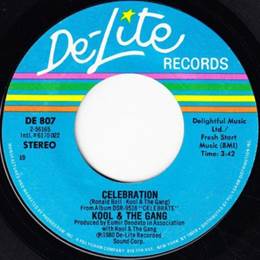
Not actually today. It was yesterday, the first day of absentee voting in Missouri. Rita and I went to the election board offices at Union Station and used our “over-65” status to cast an early ballot. It was a breeze and safely conducted in an expansive area with mask-wearing and social-distancing. Highly recommended for those eligible.
The 2020 regular season for baseball ends on Sunday. While we await the brackets for the 16 teams in the postseason, I thought it would be a good time to talk about arachnids.
Spiders, Indians, Perfectos and Cardinals: I don’t give much thought to 19th century baseball, but the Cleveland Spiders have been in the news at least twice this season. The Spiders played in the National League from 1889 to 1899. They adopted their name when a team executive joked that the skinny, long-limbed players sporting black-and-gray uniforms looked like Spiders.
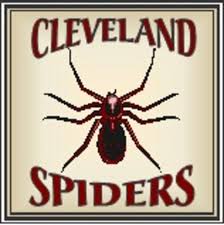
Fast forward to 2020. The Cleveland Indians are exploring a change in team name so they can move on from their Chief Wahoo image. One of the popular suggestions has been the Spiders, but there is a legacy problem. The Spiders are best known for fielding the worst team in baseball history. In 1899, their last year in existence, they finished 20-134. That’s fewer wins than the Royals will have this year in a 60-game season. Why were the Spiders so bad? Blame the St. Louis Cardinals.
The Spiders had seven straight winning seasons before the fiasco of 1899. One of the primary reasons for their success was the presence of Cy Young (below) who joined the Spiders as a rookie in 1890. In his nine years with the Spiders, he won 240 games. By the time he ended his 22-year career in 1911, he had won 511 games.

The Spiders were owned by brothers Frank and Stanley Robison. In 1899, they bought another National League team, the bankrupt St. Louis Browns (not to be confused with the future AL team of that name). The brothers gave the team a new name and color – the “Perfectos” wore red trimmed uniforms. The best players from the Spiders, including Cy Young and two other future Hall of Famers, were moved over to the Perfectos. The Spiders were treated as a sideshow and had the infamous 20-134 season. The Perfectos finished 84-67. The next year, the Perfectos changed their name to the Cardinals to match their popular red color.
As for the Spiders, they were dropped from the National League after the sad 1899 season. The Robisons sold the remaining assets to a minor league team moving to Cleveland. This new Cleveland team was in the American League which in 1901 was elevated to major league status. In 1915, the team changed its name to the Indians. After 105 years, will that change?
After the Spiders’ 20-134 fiasco, the league adopted a rule prohibiting ownership in more than one team. But for a short period of time in 2019, an owner of the Cleveland team also took ownership of a Missouri team. Rather than the Spiders and the Cardinals, it was the Indians and the Royals. John Sherman had a stake in the Indians when he purchased the Royals, but of course that was to be quickly relinquished. So Royals fans will not be seeing any Cleveland all-stars transferring to the KC roster.
Cleveland Spiders Meet Fernando Tatis and Eric Hosmer: In August, the San Diego Padres and Texas Rangers played a four game series. In Game 1, San Diego was leading 10-3 in the 8th and had the bases loaded. The Padres’ 21-year-old phenom Fernando Tatis was at the plate with a 3-0 count. Some believe in an unwritten rule that the a batter must take the next pitch in this situation. The pitch will likely be down the middle, and the batter should not take advantage and run up the score in a lopsided game. Tatis missed the take sign from his coach and instead hit a grand slam home run.

There was some controversy, but many players and sportswriters concluded that it’s a stupid unwritten rule. Is there some stage of a game where players stop competing? Is there a parallel rule that the Rangers would agree to not try a comeback in their last two innings? Remember what Yogi said – “It ain’t over ‘til it’s over.” If you asked fans if they would rather see Tatis hit a grand slam or take a pitch, I think you know the answer.
That story quickly got buried by bigger news. In Game 2, the Padres got a grand slam by Wil Myers. In Game 3, it happened again, this time off the bat of Manny Machado. Three grand slams in consecutive games. That had happened only once before in the National League. In 1895. By the Cleveland Spiders.
But wait. In Game 4, the Padres loaded the bases in the 5th inning. Former Royal Eric Hosmer came to the plate. He hit a grand slam. A new National League record. Also a new MLB record because it topped the three AL teams that had matched the Spiders at three games. Below, Eric Hosmer reaching home and celebrating with Fernando Tatis (who made the record possible by not taking a 3-0 pitch in Game 1).
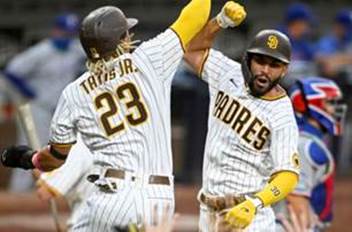
So in 2020 the Cleveland Spiders lost a place in the record book. There is of course a Yogi-ism for this, “I always thought the record would stand until it was broken.”
Below, Hosmer sports a tee-shirt celebrating the grand slams. Eric is in the third year of his 8-year/$144 million contract with the Padres. He was having a very good 2020 season (.886 OPS) until he broke an index finger while attempting a bunt. He was recently activated from the injured list and is ramping up for the postseason.

Ruth Bader Ginsburg: During the well-deserved accolades this past week for Justice Ginsburg, I noted some baseball mentions. She grew up as a fan of the Brooklyn Dodgers: “I went to Ebbets Field religiously. They released our entire elementary school class on Dodgers Day.”
Jeff Idelson, former president of the Baseball Hall of Fame, tweeted that Ginsburg enjoyed many visits to Cooperstown. “She loved the HOF and had a deep appreciation for the intersection between baseball and social history, particularly Curt Flood’s challenge of the reserve clause.”
Below, at Cooperstown, three Hall of Famers: Babe Ruth, Justice Ruth and Ty Cobb.

Twenty-Nine (29!) Runs: Two weeks ago, the Atlanta Braves beat the Miami Marlins 29-9. The number 29 jumped out at me, and I’ll get to that story. But first, some perspective.
The most runs scored in a game by a major league team is 36. The Chicago Colts (later to be known as the Cubs) beat the Louisville Colonels 36-7. That was in 1897 and is not considered as occurring in baseball’s “modern” era. [1897 Trivia: The Cleveland Spiders had a pitcher who appeared in four games in his only season in the majors. His name was Charlie Brown (not to be confused with the pitcher/manager of the Peanuts’ team).]
In the 20th century, two teams scored 29 runs. On June 8, 1950, the Boston Red Sox beat the St. Louis Browns 29-4. On April 23, 1955, the Chicago White Sox beat the Kansas City A’s 29-6.
In the 21st century (so far), two teams have scored 29 or more runs. On August 22, 2007, the Texas Rangers beat the Baltimore Orioles 30-3, the modern record for the most runs by a team in a game. On September 9, 2020, as noted above, Atlanta beat Miami 29-6. [Homer Trivia: My favorite piece of trivia from the Atlanta game is that Adam Duvall hit three homers to become the only hitter in Braves history to have two three-homer games (his first was just a week earlier). Those Braves who had one three-homer game, but never a second, include Hank Aaron, Chipper Jones, Dale Murphy, Eddie Matthews and Andruw (not a typo) Jones.]
Back to the Kansas City game in 1955 and why the number 29 jumps out at me. I was there. Kansas City was hosting the White Sox early in the A’s first season in Kansas City. It was a Saturday afternoon, and I was at the game with my dad. I had been to the season opener a couple of weeks earlier with my 8th grade pal Jay DeSimone, but this was my dad’s first A’s game. Seeing the debacle, it was also his last A’s game.
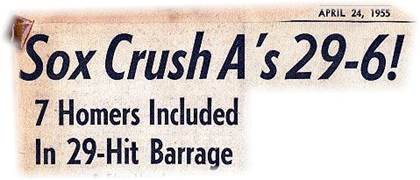
Lonnie’s Jukebox – St. Louis Shooters (Frankie and Stagger Lee): The main topic of this Hot Stove dates back to the 1890s, and so may not seem ripe for the usual rock ‘n’ roll music in Lonnie’s Jukebox. But baseball stats guru Bill James gave me an idea with this tweet:

Why is Bill James tweeting about a couple of murders in St. Louis? Well, in addition to his legendary baseball writing, James has written two books about true-crime murders (Popular Crime: Reflections on the Celebration of Violence and The Man From the Train). I agree with Bill that the better song is “Stagger Lee,” but I have a bias. I still have my 45-rpm record by Lloyd Price.
Stagger Lee: In 1895, Cy Young won 35 games for the Cleveland Spiders. His future team in St. Louis (the Cardinals, then called the Browns) won only four more games than Young, going 39-92 for the season. It was also a bad year in St. Louis for Billy Lyons. On Christmas night, Billy argued with Lee Shelton (no relation) in a St. Louis saloon and grabbed Shelton’s Stetson hat. Shelton shot Billy dead and retrieved his hat. Shelton, a pimp who went by the nickname “Stack Lee,” went to prison for the deed.
The incident entered American folklore and songs were sung with variations of the story and derivatives of the “Stack Lee” nickname. There were versions in every decade, ranging from Duke Ellington and Woody Guthrie to the Grateful Dead and Bob Dylan. Tommy Roe and Wilson Pickett made the Billboard charts with their records of the song.
But the one most of us know is by Lloyd Price who released “Stagger Lee” in late 1958. It went to #1 for four weeks in 1959 during my final semester of high school. In Price’s telling, the argument started when two men were gambling in the dark (“The night was clear and the moon was yellow…”). Billy won all of Stagger Lee’s money and his Stetson hat. Lee felt cheated (“Stagger Lee shot seven and Billy swore that he threw eight.”) and so went home and got his forty–four. He found Billy at a saloon and shot a bullet that went through Billy and “broke the bartender’s glass.”
Great lyrics. But Dick Clark censored the record because of the gambling and violence. To get play on Clark’s American Bandstand, Price went back into the studio and cut a “Bandstand” version that had Billy temporarily stealing Stagger Lee’s girl, but then feeling bad and returning her. I’m glad to say that the dice game and the forty-four are in my 45-rpm vinyl (below).

Frankie and Johnny: In October of 1899 in St. Louis, (i) the Perfectos were getting ready to become the Cardinals, and (ii) Frankie Baker shot her lover Allen Britt after he won a slow-dance contest with Nellie Bly. Frankie claimed self-defense and was acquitted. A new folklore hero entered the scene, and songs, movies and plays followed. Somewhere along the line, Allen became Johnny.
There were many variations of “Frankie and Johnny” lyrics over the decades. And as had happened with Lloyd Price and his “Bandstand” version, some artists dropped the gun violence. One of the best (worst) examples of this was Johnny Cash who limited Johnny’s pain to a slap in the face by Frankie’s sister. No gunplay.
Five versions of “Frankie and Johnny” have hit the Billboard Top-100. Johnny Cash, Brook Benton, Sam Cooke, Greenwood Country Singers and Elvis Presley (who played Johnny in his movie Frankie and Johnny). When there is gunplay, Frankie is toting a forty-four, just like Stagger Lee. Apparently the handgun of choice in St. Louis in the 1890s.
My selections from the many versions (click on the song title to listen):
“Stagger Lee” by Lloyd Price (1958)
“Frankie and Johnny” by Sam Cooke (1963)
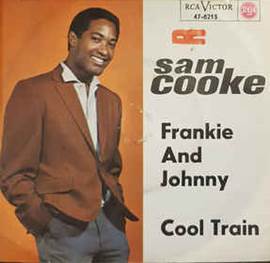
Bonus pick: “Personality” by Lloyd Price who became widely known as “Mr. Personality” after this record hit #2 in the spring of 1959.
Lonnie’s Jukebox – St. Louis Celebrators (Woody, Mike and Lonnie): This selection is a replay from a prior Hot Stove. It is being given an encore in tribute to musician/songwriter Ronald Khalis Bell who died this month at age 68. Bell and his brother Robert (a/k/a Kool) were the core members of Kool & The Gang. Ronald was the lead writer of “Celebration,” the group’s #1 hit from 1981.
The song is a staple at weddings and sporting events, and I have a special memory from 1982. After watching the Cardinals (nee Perfectos) beat the Brewers in Game 7 of the World Series, Woody Overton, Mike Ryan and I headed to Balaban’s, a landmark bistro in the Central West End. Sitting at the bar, we kept hearing the same song played on a loop all night long. It was “Celebration,” a perfect match for the evening. Whenever I hear the song, I am transported back to St. Louis in 1982.
Click here and join in the celebration.
